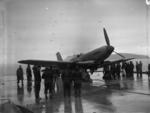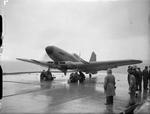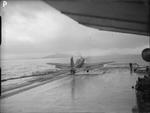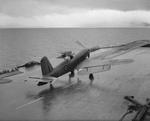Firebrand
| Country | United Kingdom |
| Manufacturer | Blackburn Aircraft Limited |
| Primary Role | Torpedo Bomber |
| Maiden Flight | 27 February 1942 |
Contributor: Alan Chanter
ww2dbaseThe Blackburn B-37, as the Firebrand was originally designated, was designed to meet the requirements of British Air Ministry Specification N.11/40 which called for a cannon-armed short-range fleet defence fighter. The first design conference took place on 25 July 1940, and a mock-up of the projected fighter was completed during the following September. In January 1941 the Ministry placed an order for three prototypes. The first prototype (DD804) was flown on 27 February 1942, piloted by Flight Lieutenant Arthur Thompson. It was powered by a 2,305-horsepower, 24-cylinder, supercharged liquid-cooled Napier Sabre III H-type piston engine, and was followed on 15 July by a second prototype (DD810) which was fitted with a wing–mounted armament of four 20-millimeter Hispano auto-cannon, racks for two 500-pound bombs, and full military equipment. This aircraft, operating from RNAS Macrihanish in Kintyre, with Lieutenant Commander Dennis Campbell (formerly a Boscombe Down test pilot) at the controls, commenced deck-landing trials aboard HMS Illustrious in February 1943. The third prototype (DD815) was completed on 15 September. The prolonged delay in getting the new fighter into production, however, was largely due to Blackburn's Brough factory being heavily committed, since August 1940, in modifying US supplied Wildcat fighters to meet the Royal Navy's immediate equipment requirements.
ww2dbaseBy June 1942 the Admiralty had reached the decision that the Firebrand I, of which nine production machines (DK363-371) had now been built, did not offer any sufficient advance in performance over the Supermarine Seafire to warrant continued production of the type as an interceptor. Nevertheless, the considerable load-carrying ability of the Blackburn aircraft suggested that it might well be developed as an admirable torpedo-strike fighter and subsequent development was therefore directed towards that end. The transformation of the Firebrand F.I into the Firebrand TF.II torpedo-strike fighter required the widening of the wing centre section by approximately eighteen inches to allow an 18-inch Mark XV torpedo to be carried between the wheel wells. The second prototype (DD810), which earlier had suffered damage as a result of an engine seizure caused by an oil pipe bursting in flight, was therefore rebuilt as the prototype for the Firebrand II. Allocated a new serial number (NV636) and equipped to carry a torpedo under the widened centre section, this machine flew again on March 31, 1943, and carried a torpedo for the first time two days later, thereby becoming the world's first single-seat monoplane torpedo-bomber. Twelve production Firebrand II aircraft (DK374-DK385) were completed although some of these eventually had their torpedo gear removed and substituted with rails for eight rocket projectiles installed beneath the wings. The Firebrand TF.II aircraft (which retained the four cannon armament) were issued to No. 708 Squadron at Lee-on–the-Solent near Portsmouth in southern England, a shore-based trials unit, in the autumn of 1944 and during mock dog-fights with Seafire aircraft they were found to be easily able to out-dive their opponents. This would be the only squadron to receive Firebrand aircraft during World War II.
ww2dbaseMeanwhile it was now rendered necessary to find an alternative engine as the RAF insisted on having priority for all Sabre engine production for their new Hawker Typhoon fighter-bomber. As the Bristol Centaurus radial engine was just coming into production and offered the required power output, the Air Ministry issued Specification S.9/43 requiring Blackburn's Brough factory to concentrate on the development of a Centaurus powered B-45 Firebrand TF.III version. Two production Firebrand II airframes (DK372 and 373) were selected for an extremely complicated conversion to accept the air-cooled radial engine and the first of these prototypes made its maiden flight on 21 December 1943. The change from a liquid-cooled engine to a large radial was no easy task made particularly difficult by the fact that that the fuselage had been designed originally to be kept slim for use with the Sabre. Fortunately few major changes to the remaining fuselage structure were found to be necessary. Twenty-four Firebrand III aircraft (DK386-DK409) followed the two prototypes during 1944. The first ten powered by the 2,400-horsepower Centaurus VII radial with the remainder with the 2,520-horsepower, Centaurus XI.
ww2dbaseThe Firebrand TF.III was followed by 102 examples of the B-46 Firebrand TF.IV (EK601-EK635, EK653-EK694 and EK719-EK740) which differed from the earlier model primarily in having a very much larger fin and aerodynamically balanced rudder, introduced as a result of some directional instability which had been experienced with the Firebrand TF.III during take-offs. This model also introduced wing-mounted air brakes and a two-position torpedo mounting. The first Firebrand TF.IV with the Centaurus IX engine flew on 17 May 1945 and on 1 September 1945, just too late to see operational service in World War II, No.813 squadron, reformed with this type at RNAS Ford.
ww2dbaseProduction continued into the post-war years with the Firebrand TF.Mk.5 and TF.Mk.5A, the latter having powered ailerons in addition to the horn-balanced rudder and elevators and the longer span aileron tabs common to all Mk.5 aircraft. Sixty-eight examples were built plus an additional forty TF.IVs brought up to TF.5 standards. The type eventually went to sea with 813 Squadron aboard HMS Implacable in October 1947 for aircrew deck landing training. TF.5 aircraft would also equip No. 827 squadron FAA for a short while from December 1950 to December 1952. Firebrand service ended when both of these squadrons were re-equipped with the turboprop Westland Wyvern S.Mk.4 in 1953.
ww2dbaseSources:
William Green: Warplanes of the Second World War-Fighters Volume 2 (MacDonald, 1961)
David Mondey: British Aircraft of World War II (Chancellor Press, 1994)
World Aircraft Information Files, File 890/34 (Aerospace Publishing Periodical)
William Green and Gordon Swanborough: The Complete Book of Fighters (Salamander, 1994)
Chris Chant: Aircraft of World War II (Dempsey-Parr, 1999)
Last Major Revision: Dec 2019
Firebrand Timeline
| 25 Jul 1940 | The first design conference for the Blackburn B-37 project took place. |
| 27 Feb 1942 | Blackburn B-37 torpedo-strike fighter took its maiden flight with Flight Lieutenant Arthur Thompson in the cockpit. |
| 15 Jul 1942 | The second Blackburn B-37 prototype aircraft took to the air. |
| 15 Sep 1942 | The third Blackburn B-37 prototype aircraft was completed. |
| 31 Mar 1943 | The first Firebrand II variant aircraft, which was the second prototype aircraft of the original variant modified to new specifications, took flight. |
| 21 Dec 1943 | The first Firebrand TF.III aircraft, equipped with Bristol Centaurus VII engine, took its first flight. |
| 17 May 1945 | The first Firebrand TF.IV aircraft, equipped with Bristol Centaurus IX engine, took its first flight. |
| 1 Sep 1945 | The first Firebrand TF.IV aircraft, equipped with Bristol Centaurus IX engine, took its second flight. |
SPECIFICATIONS
TF.5
| Machinery | One Bristol Centaurus IX 16-cyl two-row air-cooled radial piston engine rated at 2,520hp |
| Armament | 4x20mm wing-mounted Hispano cannon with 200 rounds per gun, 1x18inch (839kg) torpedo or two 1,000lb bombs or 16x60lb rocket projectiles |
| Crew | 1 |
| Span | 15.63 m |
| Length | 11.81 m |
| Height | 4.04 m |
| Wing Area | 35.58 m² |
| Weight, Empty | 5,368 kg |
| Weight, Loaded | 7,938 kg |
| Speed, Maximum | 547 km/h |
| Speed, Cruising | 412 km/h |
| Service Ceiling | 8,685 m |
| Range, Normal | 1,191 km |
Photographs
 |  |  |  |
Please consider supporting us on Patreon. Even $1 per month will go a long way! Thank you. Please help us spread the word: Stay updated with WW2DB: |
- » US Government Plans to Purge WW2 Information (17 Mar 2025)
- » WW2DB's 20th Anniversary (29 Dec 2024)
- » Wreck of USS Edsall Found (14 Nov 2024)
- » See all news
- » 1,167 biographies
- » 337 events
- » 44,601 timeline entries
- » 1,243 ships
- » 350 aircraft models
- » 207 vehicle models
- » 376 weapon models
- » 123 historical documents
- » 261 facilities
- » 470 book reviews
- » 28,520 photos
- » 367 maps
Chiang Kaishek, 31 Jul 1937
Please consider supporting us on Patreon. Even $1 a month will go a long way. Thank you!
Or, please support us by purchasing some WW2DB merchandise at TeeSpring, Thank you!